|
Related FAQs: Marine
Macro-Algae, Algae Can Be Your
Friend,
Related Articles: Avoiding Algae Problems in Marine
Systems, Coralline Algae,
Green Algae, Caulerpas, Coralline Marine Algae, Red Algae in General,
Brown Algae, Blue-Green
"Algae"/(Cyanobacteria), Diatoms, Phytoplankton,
To Pest Algae/Control , Algae Filters Articles, Marine Algae ID 1, Marine Algae ID 2, Marine Algae Control FAQs II, Marine Algaecide Use, Nutrient Limitation, Marine Algae Eaters, Culturing Macro-Algae; Controlling: BGA/Cyano, Red/Encrusting Algae, Green Algae, Brown/Diatom Algae,
/A Diversity of Aquatic
Life
Algae Can Be Your Friend, Pt. 1
|
|
|
By Bob Fenner
|
|
To Part 2
 |
New
Print and
eBook on Amazon
Marine Aquarium Algae Control
by Robert (Bob) Fenner
|
Of all the topics asked of us on our websites, hobby venues and
retail stores "maintenance" has got to be the biggest
category. Algae in pest proportions in particular, is likely the number
one cause of aquarist attrition. Not the livestock losing their lives;
aquarists leaving the hobby!
|
Is such strong emotion as fear or enmity deserving of such
simple life? Are algae problems inevitable? Are they to be
avoided, fought at all costs? The answer to all is a resounding
no! With some care in setting up an aquatic system, regular
maintenance, and especially, a bit of understanding about what
algae are and how they make their lives in our tanks, you can
make your peace with these organisms.
|
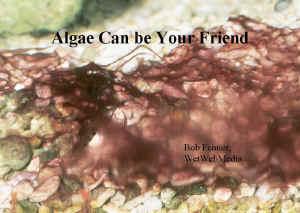
|
Algae: What Are They?
The most rudimentary algae are actually more closely related to
bacteria (phylum Monera) than anything else. These Blue-Green Algae,
aka Cyanobacteria share genetic, ultrastructural and metabolic features
with microbes, being classed with the other algae on the basis of gross
appearance and being photosynthetic.
|
The "true" algae are a part of the Protists (phylum
Protista), not the "higher" real plants (phylum
Metaphyta). Unlike metaphytans, algae lack vascular structures
(xylem, phloem), leaves, roots… and are hence called
thallophytes (subphylum Thallophyta) meaning "all about the
same plant body" in reference to their lack of more
specialized cells. Example: a vascular plant, Avicena, one of the
Mangrove Trees, with true leaves, roots and a Brown Kelp whose
cells all "do" photosynthesis, distribution, storage of
foods, gasses…
|
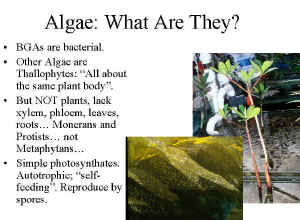
|
Algal Groups: Divisions
As
with all fields of endeavor, discussion of the algae involves its own
set of arcane terminology. Micro- versus Macro- for instance is
entirely a matter of subjective (human) appreciation. Micro-algae are
so small that the human eye can't make out a cell that exists
alone. Some groups of algae like Diatoms and Dinoflagellates are
entirely micro-algae, whereas some of the Greens are Micro- and others
Macro-algae. The larger "Kelps" are Red and Brown algae
species and are very "Macro".
|
Phycologists (a largely U.S. term for folks who study algae
scientifically) or Algologists classify the larger categories
(termed Divisions, approximately the same taxonomic ranking as
Phylum in Zoology) of algae by their photosynthetic pigment types,
storage foods, locomotory structures and the make-up of cell
walls. Example, encrusting Micro- green and hundred plus foot
stands of the Brown Kelp Macrocystis pyrifera. |
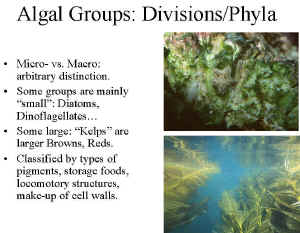
|
| Apparent color of algae can be deceiving (example:
three views of Blue-Green Algae growths in aquariums appearing very
different). The actual color of an algae depends on prevalent
storage foods and photosynthetic pigments… can/does vary with
growing circumstances, age… Microscopic examination can
easily determine an algae to at least the Division rank. |
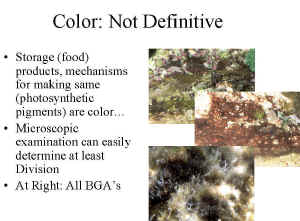
|
|
As previously stated, the Blue-Green Algae
are more closely related to Bacteria than the other,
"true" Algae. As monerans they lack definitive nuclei,
plasmids like chloroplasts, double-layered cell walls. Most
appear black to bluish in color (though there are red, tan and
other colors), and almost invariably are slippery, slimy to the
touch.
The good news for aquarists is that BGA are out-competed easily
in well set-up and maintained systems. Their presence almost
spells trouble in "balance" of a system… a lack
of circulation, aeration, too much nutrient, something missing in
the way of competing photosynthetic life…
|
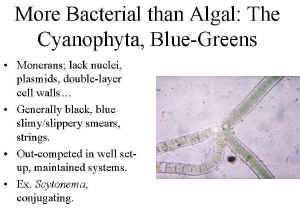
|
| These are unicellular life forms that have two
flagella (one mid-body, the other whipping around from their top)
that are utilized for locomotion. The group includes the causative
organisms for fresh and marine Velvet or Rust disease of fishes, as
well as the at-times toxic Red Tide conditions found in the seas of
the world from time to time. |
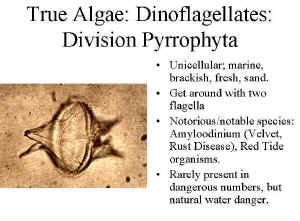
|
| These are the brownish scums, smears on the surface
of the gravel, rock of many, especially new aquariums. On close
inspection, you can make out individual cells or colonies that look
like little boxes. These holey shells are used as diatomaceous
earth in swimming pools, spas, even some types of aquarium filters
due to the insoluble nature of their make-up (silicate) and
porosity. |
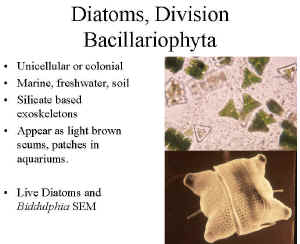
|
| Marine species that include the largest kelps,
encrusting forms, scroll like and leafy varieties. Some can be kept
in captivity with attention to iodide supplementation and awareness
of the types thermal, current needs. Examples as shown. |
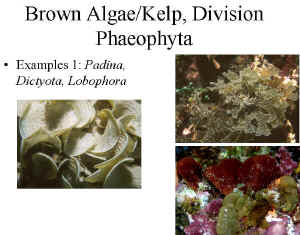
|
|
The most successful group of thallophytes on the basis of
distribution, depth, bio-mass. Some Reds live below 100 meters in
depth due to their range of photosynthetic pigments. Aquarists are
familiar with the encrusting Red Algae called Corallines; there are
some like the genus Porolithon that are important for
actually building and holding the world's tropical reefs
together. Other Reds play roles in human health (Gelidium
alginates make petri plate culture possible) and manufacturing (as
emulsifiers, stabilizers). Some are useful as human and fish
food |
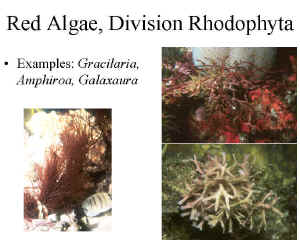
|
| The most desirable group of algae to aquarists for
their beauty, diversity, functionality… due to the habitats
they occupy in the wild, hardiness in collection, shipping,
adaptation to vacillating captive conditions. |
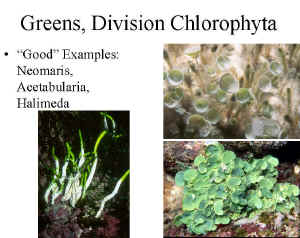
|
| Some types are "bad" on the basis of
their rapid growth, displacement of other species, lack of
attractive properties. |
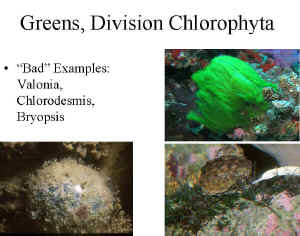
|
| Given water, light, nutrients… the allowance
of other life, algae of different kinds is a foregone conclusion.
Spores make their way into systems via the air, gear, recruited
substrates, other livestock additions. You're going to have
them whether you'd like to or not… What is up to you is
how much of what types and where… along with the mental
adjustment on your part that "cleanliness" is not
sterility. There are still folks who bleach ornaments, wipe/scrub
all down, even stoop to chemical algicides to keep their tanks
"clean"… a foolish, counterproductive notion. |
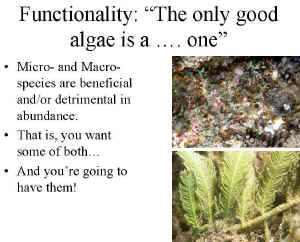
|
| 1) Optimize and stabilize a captive aquatic system,
utilizing/bio-accumulating wastes, nutrients, fixing them into
useful formats. |
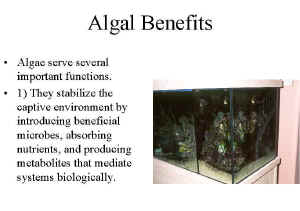
|
| Act as bio-indicators, living test kits constantly
monitoring water quality. For instance, no matter what your
colorimetric assays tell you, believe the algae if there is not
enough calcium, alkalinity for their use. |
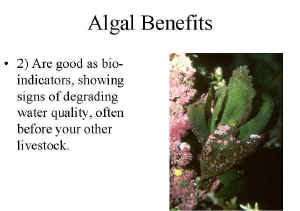
|
 |
New Print and
eBook on Amazon
Marine Aquarium Algae Control
by Robert (Bob) Fenner
|
|
|

